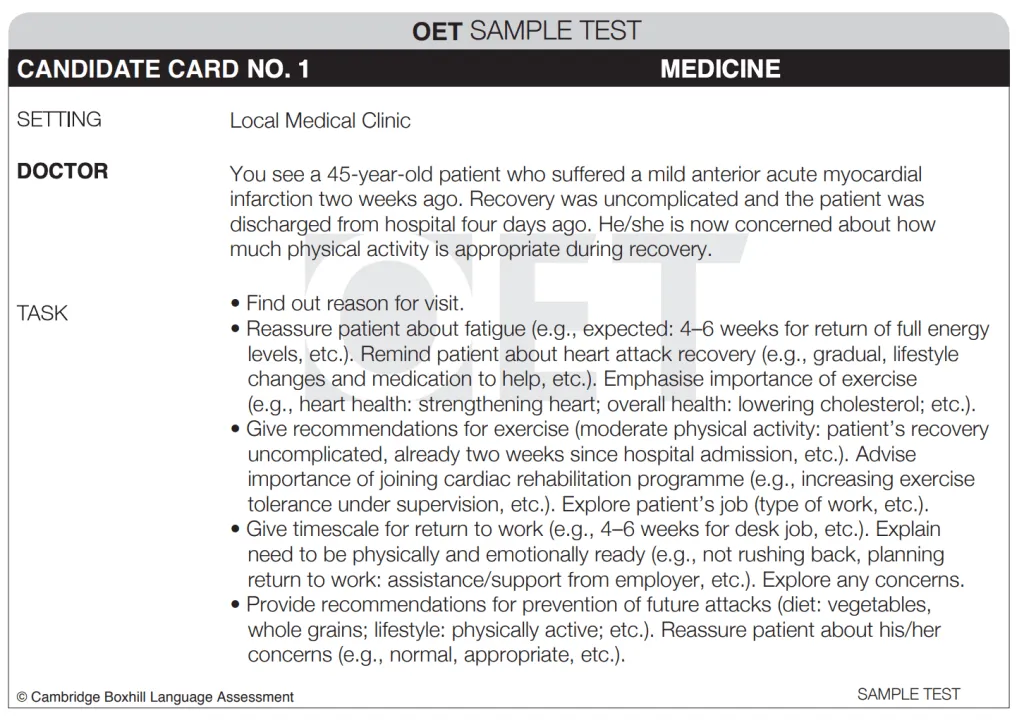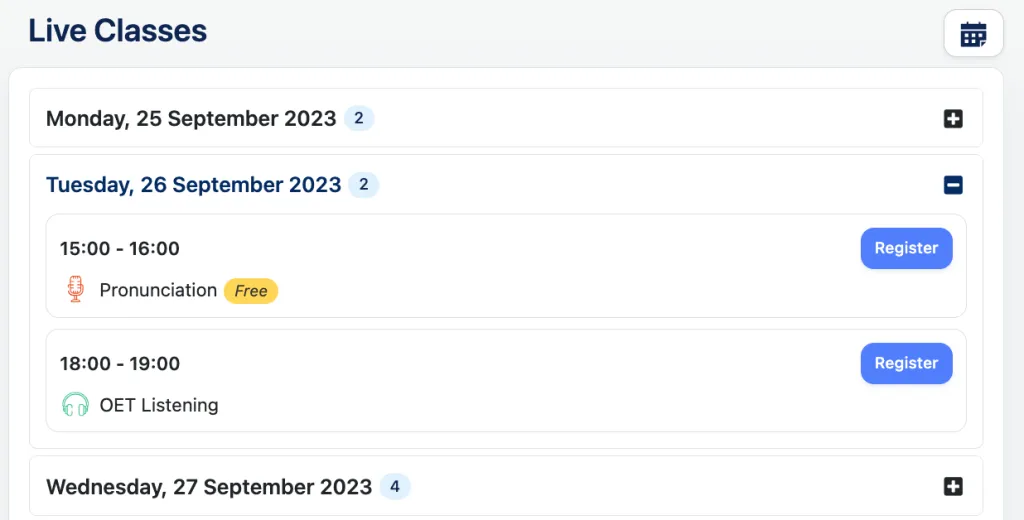The OET Speaking sub-test isn’t any easier or harder than the IELTS, PTE or the TOEFL speaking tests – it just has a different format. The OET Speaking task is designed as role play conversations between you and your examiner (known as an interlocutor). You play the role of a health professional and your interlocutor will be a patient or carer for any given scenario.
Even though its format is different from other tests, that should not discourage you from taking the OET test. What you do need to do is learn its format and master the task by preparing and practising effectively.
In this post, we will:
- start with a quick overview of the OET Speaking test,
- examine the format of the role play card,
- understand the OET Speaking Criteria,
- learn about the strong link between the role play card and grading criteria,
- learn some practice techniques that will help you prepare.
To do well on this task, you really do need to practise. We can help you with that. Just go to E2 Test Prep, sign up for the free trial and begin learning and practising today!
OET Speaking Overview – What to Expect on Test Day
The OET Speaking sub-test has one ungraded activity and two graded tasks that involve conversations with the OET interlocutor. Even though the interlocutor is your role play partner in the test, they aren’t the person who grades you. The interlocutor conducts the conversation, records your answers and sends the recordings to OET for grading. In total, the Speaking Section takes about 20 minutes.
For an in depth explanation of how you can use the OET Speaking Criteria to help with your preparation, watch this video and download our OET Speaking checklist.
The ‘Warm-Up’
The OET Speaking test does not start right away. You can expect the interlocutor to begin with a few formalities such as checking your candidate number and ID documents. After that, the interlocutor will ask you to introduce yourself and to talk a bit about your professional and work experience. This is the ‘warm-up’ task.
Don’t worry if you get off to a bumpy start – the ‘warm-up’ isn’t graded. Use the warm-up to settle in, overcome your nerves and become familiar with the interlocutor’s voice.
The Role Plays
After the warm-up questions, you will take part in two role plays. Before each role play, you will receive a role card and you will have three minutes of preparation time.
Understanding OET Speaking Role Play Cards
A typical candidate role play card looks like this:

The format of the role play card has three sections:
- the setting,
- the scenario, and
- the bullet point tasks (we will refer to the bullet point tasks as prompts).
This role play card states that the setting is a Local Medical Clinic. Though that may appear to be a simple piece of information, it is significant because it describes the context of your conversation.

This paragraph describes the scenario. In this scenario, you are the doctor, and the interlocutor is the patient. In other scenarios, the interlocutor might play the role of a carer or parent. The scenario gives you important clues about the subject of the conversation. In this example, the patient had a mild heart attack. The scenario also gives you important information about the patient. For example, we are told that the patient is concerned about doing physical activity.
If you know how to read the roleplay card, you can already begin to anticipate the flow and sequence of the conversation you will have with the interlocutor. We can expect that some of the conversation will focus on physical activity and recovery.
Next, there are the prompts as shown below. These are bullet points that you must talk about in your conversation. We will look into how to handle these prompts below – so keep reading.

The Speaking Scoring Criteria: How You are Graded
Now that you understand the format of the roleplay card better, let’s take a closer look at the criteria examiners use to grade your speaking skills.
The criteria are divided into two categories:
- First is the linguistic criteria, which are used to evaluate your language skills such as your pronunciation, fluency and correct use of grammar and pronunciation
- Second is the clinical communication criteria, which are used to evaluate your ability to communicate effectively and accurately in a healthcare setting.
- The OET Speaking Linguistic Criteria
1. The OET Speaking Linguistic Criteria
The OET Speaking linguistic criteria are made up of four sub-criteria:
| Intelligibility | Intelligibility is whether your speech is easy to understand. For example, is your voice and pronunciation clear? Is your word stress, intonation and rhythm correct? |
| Fluency | Fluency evaluates the smoothness of your speech. It includes finding the right pace (not too slow or fast), using natural pauses and, finally, avoiding stops and starts and saying too many ‘ums’ and ‘ahs’. |
| Appropriateness of language | Appropriateness is used to assess whether you use suitable language and explain things to patients in a simple, clear way. This also should take into account how you might communicate with patients of different ages and backgrounds. Try not to use technical and medical terms and language. |
| Resources of grammar and expression | This criterion looks at whether you can use a range of grammar, vocabulary and idioms accurately and flexibly. This includes using different phrases to communicate the same idea. |
The linguistic criteria are relevant across the entire role play. So your language must be appropriate throughout, whether you are relationship building, information gathering, information giving or any of the other clinical communication criteria.
2. The Clinical Communication Criteria
The OET Speaking clinical communication criteria are used to evaluate your ability to communicate effectively and accurately in a healthcare setting. There are five sub-criteria which are referred to as indicators. These indicators are:
- relationship building
- understanding and incorporating the patient’s perspective
- providing structure
- information gathering
- information giving
Now, let’s focus on ‘providing structure’. This indicator refers to whether, overall, your role play conversation has a logical and purposeful sequence. What does that mean? Let’s focus on the role play prompts below.

The prompts give us several clues as to the sequence of the conversation as well as what we will talk about. You can think of the sequence having four parts:
- First, you need to introduce yourself politely (this is not stated directly, but something you need to do).
- Second, enquire about your patient (this aligns with the first prompt on the role play card).
- Next are the middle prompts that ask you to explain some condition, procedure or process to the patient (the second prompt which refers to reassuring the patient and the third prompt that requires you give recommendations).
- Finally, there are the ending prompts where you give advice or instructions to the patient (the fourth and fifth prompts).
How to Practise for OET Speaking
Even though the OET Speaking sub-test focuses on evaluating your speaking proficiency, doing well on this section also requires having good reading and listening skills, vocabulary and pronunciation. There are a number of things you can do to practise.
1. Practise Analysing Role Play Cards
If you practise analysing role play cards before test day and understand their structure, you will be well prepared for what you see on test day. Here is another example role play you can practise analysing:

To practise, use the notes above and do the following:
| Identify the setting | Where does the conversation take place? |
| Identify the scenario | Who is the patient, what is their medical condition and what will you be talking about? |
| Introduce (unwritten prompt) | Remember to always begin by politely introducing yourself to begin building a relationship with your patient. This aligns to clinical communication criteria #1 – relationship building. |
| Enquire (prompt 1: gather general information about the patient) | This prompt is designed to assess your information gathering skills and aligns with clinical communication criteria #4 – gathering information. |
| Enquire (prompt 2: gather information to understand the patient’s perspective) | This prompt also assesses information gathering but also covers clinical communication criteria #2 – understanding the patient’s perspective. |
| Explain (prompt 3: explain a condition, process or procedure) | This prompt is designed to assess your ability to explain a condition, procedure or process and aligns with clinical communication criteria #5 – giving information. |
| Advise (prompts 4 and 5: give information in the form of patient specific instruction or advice) | These prompts are similar to ‘explain prompts’ but with a slightly different emphasis requiring you to give directions, instructions or advice specific to the patient’s circumstances. |
2. Practice Listening
Because the Role Play is a conversation with the interlocutor, you need to listen carefully to their questions and responses. The interlocutor will often give you prompts or ‘clues’ to nudge your conversation in a particular direction. For example, they may want you to give more information by asking a question requiring you to better explain their condition or what a procedure they are preparing to undergo. You need to listen carefully to pick up on these ‘cues’.
One way to practise and improve your listening skills is to listen to E2’s Everyday English podcast. Everyday English is a great opportunity to learn more on helpful topics, such as essay writing, pronunciation and grammar, while improving your listening skills.
3. Practise Pronunciation and Fluency
Following the linguistic criteria, OET examiners use the quality and clarity of your speech to grade your role play. So pronunciation and fluency are skills you need to refine and practise. If you need help with this, join our weekly FREE live pronunciation class by signing up to E2 Test Prep for a free trial. You can find the free live class in your student dashboard.

4. Build Your Vocabulary
E2 OET has on-platform lessons specifically designed to help you build your vocabulary to be OET test ready. For a lesson about OET vocabulary, you can also watch this video:
Where to Find More OET Practice
You now have a really good idea of how to effectively prepare for the OET Speaking test. Now you need to put all the strategies you’ve just learnt into practice. So for more OET preparation, head to our OET Nurses or OET Doctors page and sign up for free. We’ve got practice questions, method lessons and live classes with expert teachers – everything you need to help you get the OET Speaking score you need.

Invest in yourself. Upgrade for an E2 study package to ace your exam
Upgrade to unlock 100s of practice tests, method lessons, mock tests, and 1:1 tutorials!

Author Bio:
E2 is the world’s leading test preparation provider. Our expert teachers are fully accredited English teachers, with TESOL, British Council or OET premium provider certification, and years of OET teaching experience.




